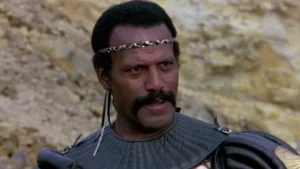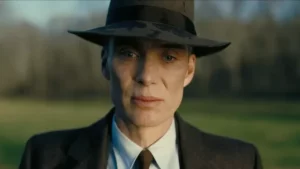
The post The Beast: Doll-drums Through the Century, by Scott Nye appeared first on Battleship Pretension.
Bertrand Bonello’s The Beast opens with a scene that both enigmatically alludes to the action to come, yet also suggests the abyss it will pointedly explore without resolving – Gabrielle (Léa Seydoux), an actress in 2014 Los Angeles, walks into a green screen volume, where she takes direction from an offscreen director (Bonello). He walks her through a scene, where she will pick up an unseen knife from an unseen table and confront an unseen beast. Gabrielle, evidently every bit the actress Seydoux is, has little trouble imagining the space, and given the blood-curdling scream she emits, little trouble imagining the beast either.
This version of Gabrielle will remain offscreen for a while longer. We’ll spend most of the first half with two others – in 2044, she’s weighing whether to take part in a new trend and purify her DNA; in 1910, she’s a renowned pianist with a vague fear of some looming catastrophe. In each time period, she’ll mean a man named Louis (George MacKay), whose own troubles are more diverse. She, in all three, is lonely, isolated, and fearful of something outside herself. In all three, he pursues her, but in the cryptic way Giorgio Albertazzi sought after Delphine Seyrig in Last Year at Marienbad. Where that film posited a man who concealed his violence with refined manners, Louis is split into three people, who represent different sides of masculine courtship – gentleness in the future, violence in the present, and genteel condescension in the past – each of which hide a kind of brutality lurking behind the possibility of all heterosexual cisgender coupling.
Is that the beast? Louis, at times, thinks so. But in Henry James’ novella The Beast in the Jungle, on which the film is inspired more than based, the beast is more cleanly understood as the loneliness in which its central character, John Marcher, lives while fearing an abstract, undefined beast that will one day consume him. And so it does, etc. The particular parallels between the novella and the film are largely indirect, and where they are present, are gender-swapped, I’d say productively so. The social strictures of James’ time and place (Northeastern American and European moneyed society in the late 19th century) are well understood for how they isolated the individual for the pursuit of mannered comfort. The strictures of contemporary society are no less prevalent, though less concretely understood.
Bonello is, in one sense, interrogating them. The growing fear of the future is a major theme, largely through our sense that technology will decimate our identities and leave us wandering through past cultures (Gabrielle’s only brief escape is to a nightclub that hones in on music from a different 20th century year every night) unless the environment takes us down first (in 2014 Los Angeles, via an earthquake; in 1910 Paris, the great flood). Does this certainty of our own collapse become a self-fulfilling prophecy? Does fear of strangers determine their danger? At what point does identification as “involuntarily celibate” condemn men to that state permanently? Do all these resolutions require action, or is their assumed mindset sufficient to enshrine them? Is every beast a creation before it’s a reality? Do we instinctively fear what we cannot see, and create it to give life to it?
If this could become rote academic musing, Bonello’s approach resists it. His screenplay (from a story in collaboration with Guillaume Bréaud and Benjamin Charbit) is richly evocative and resistant to direct inquiry. His dialogue is often seductive, only to turn on a dime towards the perverse. He seems most directly disgusted by the rough present (those who live in it often are), but his portraits of the early 20th century and the looming future present aesthetic pleasures that conceal equally discomforting realities. The direct line is drawn in 2014, where Gabrielle housesits for a vacationing yet omnipresent couple who constantly pester her with calls at all hours spurred by alarm systems, cameras, and nosey neighbors to ensure their lush property is safe; outside lurks its greatest threat, a kid (Louis again) from a similar home whose identification with the incel movement is leading him on a dangerous trajectory. We lie to ourselves about what danger looks like. This opens us up to reconsider what we understand of Louis in the other time periods, if indeed we can understand him at all.
Without directly insisting on these contrasts and comparisons, the rhythm of the film invites them. Like similar films that takes place in disparate time periods, recasting their actors in complementary roles (The Fountain and Cloud Atlas came to mind often), The Beast’s beauty and grace lives and dies on its editing. Anita Roth’s credits are not the sort that would suggest this level of achievement, but the urgency she brought to B.P.M., the haunted lingering in Bonello’s own Zombi Child, and the elliptical elusion of identity in Madeleine Collins all come to bear majestically here. At a patient 145 minutes, it would be a lie to say The Beast flies by, but it doesn’t need to – it urges you to linger in every moment, drawing out the pleasure, pain, and mystery it lives in.
In every moment its rest could consume it, Seydoux and MacKay, and more pressingly Bonello’s trust in them, maintain its quiet eroticism. Their glances are so suggestive of concealed desire, the most electrifying moment comes when 1910’s Gabrielle imitates the neutral expression her husband’s doll factory places on its products. Louis is struck speechless; I, breathless. She, always an interesting and beautiful actress, exploded out of the pandemic a full-fledged artist with diverse performances in Deception, The French Dispatch, and especially France that redefined and expanded the possibilities of what she was capable of onscreen. The Beast is the next big step, a trio of roles playing a central emotional theme, a constant state of fear mixed with determination to assert oneself against the inevitability of danger.
It ends where it began, and yet, this echo and repetition is so much grander in the fear it elicits than where we ever thought we’d get.
The post The Beast: Doll-drums Through the Century, by Scott Nye first appeared on Battleship Pretension.
The post The Beast: Doll-drums Through the Century, by Scott Nye appeared first on Battleship Pretension.




